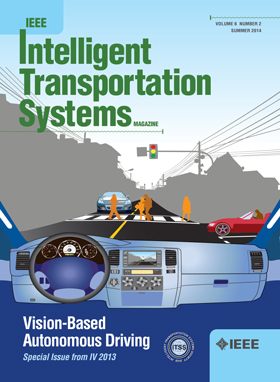Attentive Radiate Graph for Pedestrian Trajectory Prediction in Disconnected Manifolds
IF 8.4
1区 工程技术
Q1 ENGINEERING, CIVIL
IEEE Transactions on Intelligent Transportation Systems
Pub Date : 2025-04-10
DOI:10.1109/TITS.2025.3555390
引用次数: 0
Abstract
Pedestrian trajectory prediction grapples with the demanding feat of modeling complex interactions and learning multimodal distribution to navigate different human-centric environments. Despite superior performance in reducing distance-based metrics, recent works tend to predict out-of-distribution trajectories, as the distribution of forthcoming paths comprises a blend of various manifolds that may be disconnected. These unrealistic trajectories can potentially jeopardize the safety of traffic participants and result in significant damage. To meet these challenges, we propose DMPred, a graph-based generator adversarial network that generates realistic multimodal trajectory predictions by better modeling the social interactions of pedestrians across different scenes in disconnected manifolds. The core of DMPred is an attentive radiate graph sequence constructed by considering the localized influence radiating from pedestrian movements, which is followed by a spatiotemporal extractor that stores and reuses potentially forgotten neighboring pedestrian information to allow for better extraction of complex interactions. Additionally, a collection of generators is utilized for forecasting, which incorporates spectral clustering on trajectories during the prior learning process of multiple generators to help reduce model redundancy and enhance flexibility for various prediction scenarios. Through extensive experiments on multiple real-world and simulation datasets, we demonstrate that DMPred obtains highly competitive results with efficacy in predicting realistic multimodal trajectories.非连通流形中行人轨迹预测的注意辐射图
行人轨迹预测与建模复杂的相互作用和学习多模态分布,以导航不同的人类为中心的环境要求的壮举。尽管在减少基于距离的指标方面表现优异,但最近的工作倾向于预测分布外轨迹,因为即将到来的路径分布包括各种可能断开的流形的混合。这些不切实际的轨迹可能会危及交通参与者的安全,并造成重大损害。为了应对这些挑战,我们提出了DMPred,这是一个基于图的生成器对抗网络,通过更好地模拟不同场景中行人在不相连流形中的社会互动,生成现实的多模态轨迹预测。DMPred的核心是一个细心的辐射图序列,它考虑了行人运动的局部影响,然后是一个时空提取器,存储和重用可能被遗忘的邻近行人信息,以便更好地提取复杂的相互作用。此外,利用一组生成器进行预测,在多个生成器的先验学习过程中对轨迹进行谱聚类,有助于减少模型冗余,增强对各种预测场景的灵活性。通过对多个真实世界和模拟数据集的广泛实验,我们证明了DMPred在预测现实多模态轨迹方面具有高度竞争力的结果。
本文章由计算机程序翻译,如有差异,请以英文原文为准。
求助全文
约1分钟内获得全文
求助全文
来源期刊

IEEE Transactions on Intelligent Transportation Systems
工程技术-工程:电子与电气
CiteScore
14.80
自引率
12.90%
发文量
1872
审稿时长
7.5 months
期刊介绍:
The theoretical, experimental and operational aspects of electrical and electronics engineering and information technologies as applied to Intelligent Transportation Systems (ITS). Intelligent Transportation Systems are defined as those systems utilizing synergistic technologies and systems engineering concepts to develop and improve transportation systems of all kinds. The scope of this interdisciplinary activity includes the promotion, consolidation and coordination of ITS technical activities among IEEE entities, and providing a focus for cooperative activities, both internally and externally.
 求助内容:
求助内容: 应助结果提醒方式:
应助结果提醒方式:


